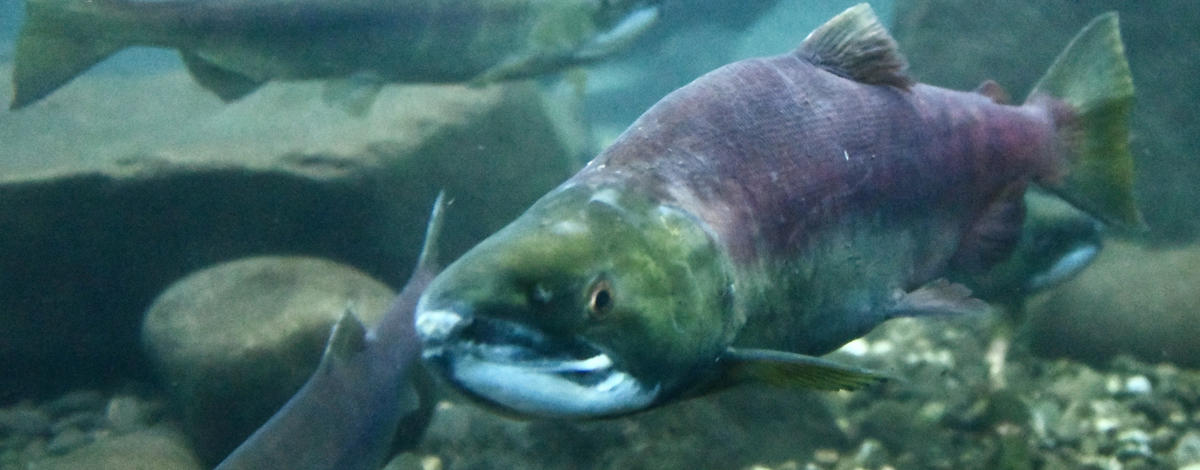Signs are promising for an improved Idaho sockeye run based on dam counts on the Columbia and Snake rivers. Through mid July (July 17), 1,535 have crossed Lower Granite Dam about 30 miles downstream from Lewiston. The run is already the second-highest in the last decade and third-highest since 1975 with more fish expected to cross in the coming days and weeks.
Lower Granite is the last of eight dams the fish cross in their migration to the Sawtooth Basin near Stanley, a trek of 900 miles and 6,250 vertical feet. After crossing Lower Granite Dam, the fish still have about 450 miles to go.
Biologists expect about 50 to 60 percent of the sockeye that cross Lower Granite Dam will eventually reach the Sawtooth Basin during normal summer river conditions. The 10-year average return to the Sawtooth Basin is 350 fish, which includes sockeye that were transported from Lower Granite Dam in 2015 and 2021.
Here’s how the current return stacks up against that last decade of total annual sockeye returns at Lower Granite Dam:
2022 through July 17: 1,535 (and counting)
2021: 645
2020: 640
2019: 81
2018: 276
2017: 228
2016: 816
2015: 440
2014: 2,786
2013: 757
Biologists are also encouraged by the higher percentage of returning fish from the Springfield Hatchery, which is used solely to raise young sockeye for release into the headwaters of the Salmon River to migrate to the ocean. The hatchery is located west of Blackfoot and was converted to sockeye production in 2013. This year could mark the highest return of adult sockeye that originated from the Springfield Hatchery.
The improved sockeye return comes on the heels of improved Chinook returns to Idaho. For the first time in several years, Idaho anglers have been able to fish for Chinook in all rivers that traditionally provide a Chinook fishing season.
Part of the reason for the rebound is improved ocean conditions that salmon need to survive during their years in the Pacific Ocean before starting their return migration to Idaho. Sockeye typically spend two years in the Pacific before returning, but a small percentage spend longer.
While the number of sockeye crossing Lower Granite Dam is encouraging, they still have about 450 miles to complete their journey, which can be hampered by a variety of factors, including low water in the Snake and Salmon rivers and warm temperatures that can slow their progress and make their final migration to the Stanley area more difficult to complete.
The 2021 return to the Sawtooth Basin was 240 sockeye, however, it was an unusual year because only 55 made the entire migration on their own. Due to unusually hot weather in June that spiked river temperatures to levels that were dangerous to sockeye, biologists opted to pull 185 sockeye from the fish trap at Lower Granite Dam and truck them to the Eagle Hatchery to ensure some would be available for spawning.
Under normal circumstances, all of those fish would have attempted to swim all the way to the Sawtooth Basin — a journey that is valuable to Idaho sockeye recovery because it ensures the hardiest fish are available for spawning.
“From a genetic perspective, sockeye that migrate all the way back to the Sawtooth Basin have a level of fitness that we want in our captive breeding program,” said Lance Hebdon, Fisheries Bureau Chief.
Idaho’s sockeye recovery program does not rely solely on adults returning from the ocean. Since its inception in 1990s, Fish and Game has employed a “spread the risk” strategy that includes sockeye raised in the wild and left to naturally migrate to and from the Pacific. There are also sockeye that are raised from egg to adult in hatcheries that serve as an insurance policy if none – or few – adults naturally return from the ocean.
Having natural and captive broodstock means biologists can spawn, raise and send more young fish to the ocean, and if conditions are in their favor, welcome back hundreds, or potentially thousands, of adults from the ocean.
In order to thrive, all of Idaho’s salmon need good rearing and migration conditions in Idaho’s lakes and rivers, adequate food in the ocean, and cool rivers for their return to Idaho. When all three are available, the fish have repeatedly shown they are capable of bouncing back and returning in higher numbers.
If any, or all, of those factors are lacking, Idaho typically has modest-to-low sockeye returns, but Fish and Game’s sockeye program is designed to use captive breeding and hatcheries to bridge the gap between lean years and productive years and try to ensure Idaho’s sockeye’s survive.
When Idaho sockeye were listed in 1991 under the federal Endangered Species Act, only four adult sockeye returned to the Sawtooth Basin. The total number of sockeye that returned between 1991-99 was 23 fish, including two years when no sockeye returned.

